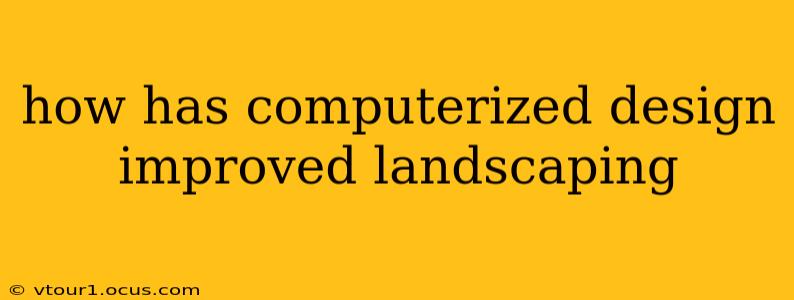Landscaping, once a field reliant on hand-drawn sketches and years of experience, has been revolutionized by computerized design. This shift has drastically improved efficiency, accuracy, and the overall client experience, leading to more creative and sustainable landscape projects. From initial conceptualization to final installation, computerized design tools have transformed the industry.
What Software is Used in Landscape Design?
Several software packages cater specifically to landscape design needs. Popular choices include Realtime Landscaping Architect, SketchUp, and Autodesk AutoCAD. These programs offer a range of features, from 3D modeling and visualization to automated cost estimations and material calculations. The choice of software often depends on the designer's experience, the project's scale, and the client's budget.
How Does Computerized Design Help with Visualization?
One of the most significant improvements is the ability to create realistic 3D visualizations. Clients can "walk through" their future landscape before a single plant is purchased or a shovel hits the ground. This interactive experience allows for immediate feedback and adjustments, ensuring the final product aligns perfectly with the client's vision. This drastically reduces misunderstandings and costly revisions later in the process.
Can Computerized Design Improve the Accuracy of Landscaping Plans?
Absolutely! Computerized design eliminates the potential for hand-drawing inaccuracies. Precise measurements, plant placement, and material quantities are easily calculated and displayed, minimizing waste and ensuring a seamless installation process. This precision also extends to grading and drainage plans, reducing the risk of costly errors during construction.
Does Computerized Design Help with the Sustainability of Landscaping Projects?
Yes, in several ways. Software can help designers assess sunlight exposure and water needs, enabling them to select plants that thrive in the specific microclimate. This reduces the need for excessive irrigation and minimizes the use of pesticides and fertilizers, contributing to a more environmentally friendly landscape. Furthermore, some programs allow for the integration of sustainable materials and features, such as rainwater harvesting systems or permeable paving.
How Does Computer Software Affect the Cost of Landscaping?
While the initial investment in software and training might seem like a cost, the long-term benefits often outweigh this. Improved accuracy reduces material waste, minimizes labor costs associated with rework, and streamlines the entire project. The ability to accurately estimate costs upfront also allows for better budgeting and transparency with clients.
What are the Benefits of Using Computerized Design in Landscaping?
In short, computerized design offers a multitude of benefits:
- Enhanced Visualization: Clients can see the finished product before construction begins.
- Increased Accuracy: Precise measurements and planning minimize errors and waste.
- Improved Efficiency: Streamlined workflows and automated calculations save time and resources.
- Greater Sustainability: Optimized plant selection and integration of sustainable features.
- Better Communication: Clearer communication between designers, contractors, and clients.
- Cost Savings: Reduced waste, labor, and rework translate to lower overall project costs.
The integration of computerized design has undeniably transformed the landscape design industry, enhancing its efficiency, precision, and creative possibilities while promoting environmentally conscious practices. It's a pivotal advancement that benefits both designers and clients, resulting in more beautiful, sustainable, and cost-effective landscapes.
